科技文本翻译
- 格式:ppt
- 大小:406.00 KB
- 文档页数:55

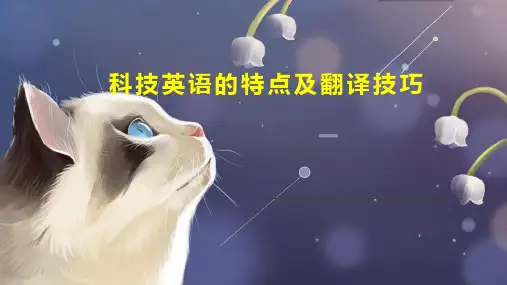
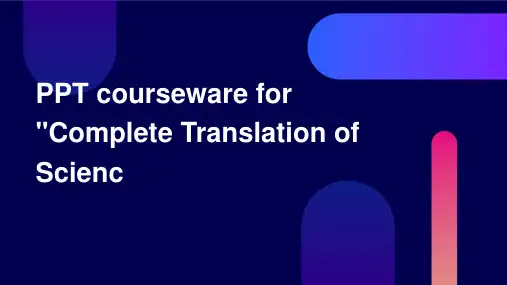
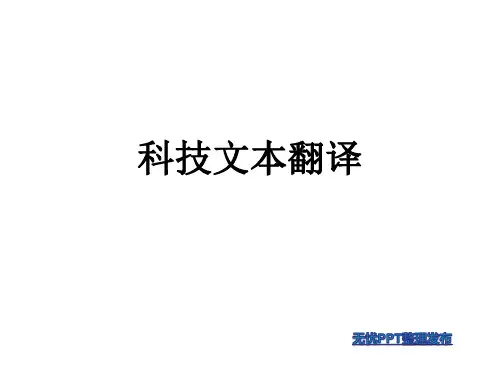
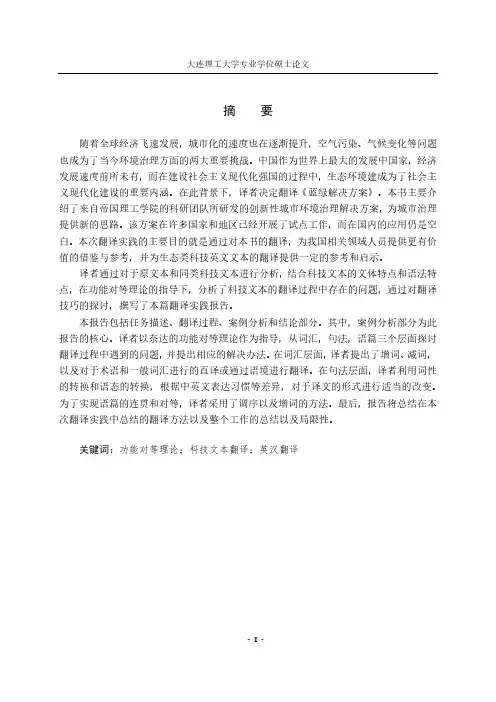
大连理工大学专业学位硕士论文摘要随着全球经济飞速发展,城市化的速度也在逐渐提升,空气污染、气候变化等问题也成为了当今环境治理方面的两大重要挑战。
中国作为世界上最大的发展中国家,经济发展速度前所未有,而在建设社会主义现代化强国的过程中,生态环境建成为了社会主义现代化建设的重要内涵。
在此背景下,译者决定翻译《蓝绿解决方案》。
本书主要介绍了来自帝国理工学院的科研团队所研发的创新性城市环境治理解决方案,为城市治理提供新的思路。
该方案在许多国家和地区已经开展了试点工作,而在国内的应用仍是空白。
本次翻译实践的主要目的就是通过对本书的翻译,为我国相关领域人员提供更有价值的借鉴与参考,并为生态类科技英文文本的翻译提供一定的参考和启示。
译者通过对于原文本和同类科技文本进行分析,结合科技文本的文体特点和语法特点,在功能对等理论的指导下,分析了科技文本的翻译过程中存在的问题,通过对翻译技巧的探讨,撰写了本篇翻译实践报告。
本报告包括任务描述、翻译过程、案例分析和结论部分。
其中,案例分析部分为此报告的核心。
译者以奈达的功能对等理论作为指导,从词汇,句法,语篇三个层面探讨翻译过程中遇到的问题,并提出相应的解决办法。
在词汇层面,译者提出了增词、减词,以及对于术语和一般词汇进行的直译或通过语境进行翻译。
在句法层面,译者利用词性的转换和语态的转换,根据中英文表达习惯等差异,对于译文的形式进行适当的改变。
为了实现语篇的连贯和对等,译者采用了调序以及增词的方法。
最后,报告将总结在本次翻译实践中总结的翻译方法以及整个工作的总结以及局限性。
关键词:功能对等理论;科技文本翻译;英汉翻译A Report on E-C Translation of Ecological EST under the Guidance of Functional Equivalence TheoryA Report on E-C Translation of Ecological EST under the Guidance ofFunctional Equivalence TheoryAbstractWith the rapid development of the global economy, the speed of urbanization is gradually increasing, and problems such as air pollution and climate change have become two major challenges in environmental governance. As the largest developing country in the world, China has experienced an unprecedented economic increasing. The construction of the ecological environment has been a core of socialist modernization. Considering the background, the translator decides to translate Blue Green Solutions. This book mainly introduces innovative urban environmental governance solutions developed by the scientific research team of Imperial College to provide new ideas for urban governance. The program has already carried out pilot work in many countries and regions, but its application in China is still blank. The main purpose of this translation practice is to provide a more valuable reference for the relevant fields in China through the translation of this book and to provide reference and inspiration for the translation of ecological EST texts.The translator analyzes the source text and the parallel text combining with the stylistic and grammatical characteristics of the EST text, under the guidance of functional equivalence theory, solves the problems encountered in the translation process and finally writes this translation practice report.This report includes task introduction, translation process, case study and conclusion. The case study is the core of this report. The translator uses Nida’s functional equivalence theory as a guide to explore the problems encountered in the translation process from the three levels of lexical level, syntactic level, and discourse level, and proposes corresponding solutions. At the lexical level, the translator uses addition and omission, as well as literal translation of terms and contextual translation of common words. At syntactic level, the translator uses conversion to make appropriate changes to the form of the translation based on differences in Chinese and English expression habits. In order to achieve coherence and equivalence at discourse level, the translator adopts the method of rearrangement and addition. Finally, the report will have a conclusion of the translation methods in the translation practice and the summary and limitations of the entire work.Key Words:Functional Equivalence; EST Translation; E-C Translation目录摘要 (I)Abstract (II)Chapter 1 Introduction (1)1.1 Background of the Translation Project (1)1.2 Significance of the Translation Project (2)Chapter 2 Theoretical Basis (3)2.1 EST and EST Translation (3)2.1 Overview on Nida’s Translation Theory (3)2.2 Nida’s Functional equivalence (4)2.3 The Application of Functional Equivalence (6)Chapter 3 Translation Process (7)3.1 Pre-Translation Preparation (7)3.2 Analysis of the Source Text (8)3.2.1 Lexical features (8)3.2.2 Syntactic Features (9)Chapter 4 Case Study (11)4.1 Translation at Lexical Level (11)4.1.1 Literal Translation (11)4.1.2 Contextual Translation (13)4.1.3 Amplification and Omission (14)4.2 Translation at Syntactic Level (15)4.2.1 Nominalizations to Verbs (15)4.2.1 Passive V oice to Active V oice (16)4.3 Translation at Discourse Level (17)Chapter 5 Conclusion (21)5.1 Findings in the Translation Process (21)5.2 Summary and Limitations (22)References (23)Appendix I Term Bank and Abbreviation (25)Appendix II Source Text and Target Text (29)Acknowledgments (88)大连理工大学学位论文版权使用授权书 (89)Chapter 1 Introduction1.1 Background of the Translation ProjectUrbanization is characteristic of the modern world. At present, economic and social development is in an important strategic transition period, and urbanization has been given an important historical mission. However, the impact of urbanization on the ecological environment cannot be ignored. How to improve the quality and benefits of urbanization development in accordance with the concept of green development is a challenge faced by China and all countries in the world. As an applied discipline, the translation should make its due contribution to people’s further understanding of the world. It is the mission of our translation students to translate valuable foreign books or materials into Chinese and introduce them to Chinese people to expand international cooperation and promote the better development of our economy.My translation project is a technological report entitled Blue Green Solutions, edited by Čedo Maksimovic and some other contributors. This technological report was fun ded by Climate-KIC, which is a Knowledge and Innovation Community supported by the European Institute of Innovation and Technology. Čedo Maksimovic, the major contributor to this guidebook, is from Imperial College London. His research fields include applied fluid mechanics in urban water systems: storm drainage, urban flooding water supply and interactions of urban water systems and infrastructure with the environment. In addition to lecturing on the MSc and UG courses, Prof. Maksimovic serves as a project coordinator of EPSRC, EU and UNESCO projects in the UK, and other projects in Europe and in other continents dealing with the above topics. This translation project comes from the BGS translation cooperation project that my supervisor discussed with the author at Imperial College.Blue Green Solutions is a guidebook that presents an innovative framework to systematically unlock the multiple benefits of city natural infrastructure [1]. Chapter 1 gives an introduction of Nature Based Solutions (NBS) and Blue Green Solutions (BGS) to prove that the NBS is a mono-function way, which has become increasingly unsuitable for cities nowadays. The Blue Green Dream (BGD) project created a framework for synergizing urban water and plant systems to provide effective, multifunctional Blue Green Solutions (BGS) to support urban adaptation to climatic change. Chapter 2 describes the development process of BGS, the limitations of traditional NBS in urban transitions and the innovative urban transition of BGS. It is pointed out that the BGS is not based on a single discipline to provide solutions for urban transition but is based on the coordination and communication of multiple discipline teams. Chapter 3 describes the design process when planning urban transition with BGS, and reduces the cost to the minimum by coordinating the participation degree of each stakeholder to realizeA Report on E-C Translation of Ecological EST under the Guidance of Functional Equivalence Theorythe maximization of the benefits of urban transition. Chapter 4 describes how to quantify the economic and ecological benefits of the blue-green solution. Chapter 5 is a case study of six pilot units.1.2 Significance of the Translation ProjectThis translation project is significant in the following two senses:Academic significance. BGS elaborated on the relationship between urban design and climate change from the perspective of urbanization. Each contributor is an expert in environmental engineering, civil engineering, energy and economics, and explains the whole process of BGS from pre-design to construction to benefit evaluation. After an in-depth study of climate change, they created new solutions that were different from traditional NBSs. Secondly, the study of climate change involves many factors, including science, energy, politics and economy. Therefore, it is not a simple matter to make it clear. This guidebook makes a detailed case study of the communities, campuses and other places that adopt the BGS to realize construction or renovation, then proves the correctness and innovation of the theory with practice. So this guidebook provides a good platform for the target language readers and related researchers.Realistic significance. The special feature of the BGS is that its target group can be a professional group, as well as developers, factory managers, governments, investors and other stakeholders. This paper presents the theoretical knowledge that BGS takes and the benefits that BGS brings. Translating this guidebook into Chinese is valuable for relevant experts and stakeholders to use for reference in designing urban construction or renovation. In addition, translating this paper into Chinese will provide a window for the public to understand the close relationship between urban development and climate change. As the biggest developing country in the world, China will contribute significantly to global environmental protection and economic development by running her own affairs well. Therefore, translating this book into Chinese can provide more reference programs for China in the construction of ecological civilization.大连理工大学专业学位硕士论文Chapter 2 Theoretical Basis2.0 EST and EST TranslationIn the first chapter, the content of the source text is about the new research in the area of environmental engineering, which is typical English for Science and Technology (EST). Many related studies on the translation of EST texts have shown that the style of EST is characterized by standard language, objective statement, strong logic, a large amount of information and a high degree of specialization. Compared with literary translation, scientific translation requires a translation that is accurate and expressive in content, well-structured and well-defined [2,3]. Therefore, when translating EST texts, the translator must analyze the characteristics and language features of the source text.In the translation process, the translator believes that the ultimate purpose of EST translation is using simple, accurate language to express the same concepts and information as the original to promote scientific and technological knowledge. Therefore, in addition to considering the basic concepts of the translation such as “literal translation” and “parallel translation,” it should also pay attention to the equivalence in the function of the target text and the source text to make sure that the reader or audience may have the same response of the source language receptor [4]. Therefore, from the perspective of the requirements of EST translation and the reader’s response, EST translation coincides with Nida's functional equivalence theory.2.1 Overview on Nida’s Translation TheoryNida’s basic translation ideas can be summarized in the following three points. ①Translation is a communicative activity between languages. ②The goal of translation is to transfer the meanings. ③In order to transfer meanings, the form of the source texts can be adjusted [4]. Nida regards translation as a cross-language, cross-cultural communicative activity, which is in line with the purpose of the EST translation, that is, to convey the latest research in related disciplines, and to provide new research methods for the domestic academic circles. For the second point, Nida’s explanation is: To make the source text reader and target text readers communicate with each other, the meaning of the source texts must be clearly transferred. This is also the most basic requirement for translation of the source text. Since the habit of Chinese and English expressions are not the same, in order to achieve translation, the forms of language expressions must be changed. EST has its own textual characteristics, and we must correctly grasp these characteristics in translation, and reproduce the information of the source language with the closest and natural equivalents[5]. This is the core point of functional equivalence theory.A Report on E-C Translation of Ecological EST under the Guidance of Functional Equivalence TheoryIn addition to functional equivalence theory, Nida believes that the translation process can be divided into following four stages, namely analysis, transfer, restructuring and test [5]. ①Analysis is mainly to determine the meaning of the original text. The meaning here refers to the meaning of words, phrases, grammar, syntax and discourse structure. That is, the translators must grasp both the meaning of the content and the characteristics of the form. ②Transfer is to transfer the information analyzed from the source language to the target language. ③Restructuring is to reorganize the words, syntax and discourse features to achieve maximum comprehension of the target receptor. ④Test. To expose the deficiency of translation based on testing the reader’s response. Transfer, restructuring and test is a process that needs to be repeated in the translation process in order to do the best translation. Therefore, in the translation process, the characteristics of the original text should be analyzed first. After having a complete grasp of the content and linguistic characteristics of the original text, it should be translated sentence by sentence.2.2 Nida’s Functional equivalenceThe core of Nida’s “f unctional equivalence” theory is to make the translated text arouse the same effect on target readers as close as possible as the source text on its readers [6]. Dynamic equivalence (or functional equivalence) is an approach to translation in which the original language is translated “thought for thought” rather than “word for word” as in form equivalence. For Nida, in translation, the meaning is first, and form is second, namely the priority of functional equivalence over formal equivalence. The “function” of a language refers to the verbal role that a language can play in its use. Different languages must be different in grammar or expression habits, but they can have the same or similar functions to each other. So that the key to translation is the target text can produce the corresponding effect of the source text in the cultural background of the source language in the cultural background of the target language. Nida emphasizes that the key to translation is “equivalence,” “in formation,” “meaning,” and “style” [7].As mentioned earlier, “translation is a communicative activity,” the purpose of translation is to seek the “equivalence” of the source language and target language. The information conveyed by translation is not only superficial textual information but also deep cultural and social information. Nida expounds dynamic equivalence from four aspects: lexical equivalence, syntactic equivalence, textual equivalence and stylistic equivalence [8].(1) Lexical equivalence: The meaning of a word is decided by its use in the language. Find the corresponding meaning in the target language.(2) Syntactic equivalence: Translators must not only know whether the target language has such a structure, but also understand how often this structure is used.大连理工大学专业学位硕士论文(3) Discourse equivalence: In the discourse analysis, we can not only analyze the language itself but also how the language conveys the meaning and function in a specific context.(4) Stylistic equivalence: Translation works of different styles have their own unique language characteristics. Only when mastering both the source and target language characteristics and being proficient in using both languages, can translators create a translation work that truly reflects the source language style.Under the framework of functional equivalence theory, EST translation should follow the following principles [9]:(1) Faithfulness to the original author: in translation, we should pay special attention to the unity of the target text and the original text, and follow the principle of “faithfulness to the original author.” On the basis of this principle, the translator should give full play to the role of the original text, requiring the translator not only to understand the thinking mode of the source text but also to fully understand the communicative function of the source text to the source text.(2) Serving the target language receptors: take full account of the r eader’s understanding of the translation and use the most “natural” form of language translation. This “naturalness,” on the condition that the target language recipient’s understanding needs are satisfied, includes two meanings: the translation should be authentic, and the translation should be read in a natural way, so as to avoid translationese.(3) Fully considering the function of information: in the EST translation, the translator should fully consider the cultural background of the target language, and based on this background, fully consider the information function. If the target readers have strong professional knowledge of related fields, maximally retain the original style and words of science and technology in the text, English professional term will not affect their reading and understanding, the target language reader can completely rely on their professional skills to understand English paragraph means of science and technology. If the target language reader has the weak professional knowledge, the translator should strive to achieve the equivalence from words to sentences as far as possible so as not to affect the target language readers to further understand the meaning and improve their reading experiences.In translation practices, Nida believes that the most important equivalence is the semantic equivalence. For EST translation, the author believes that the translator must first grasp the style of EST, that is, the stylistic characteristics of EST must be clarified in the pre-translation preparation. Secondly, translators should adhere to the principle of lexical equivalence and semantic equivalence in translation, so that the content of the source texts has the same effect as the source texts.A Report on E-C Translation of Ecological EST under the Guidance of Functional Equivalence Theory2.3 The Application of Functional EquivalenceAs mentioned above, the core of functional equivalence is that the receptors’ response to the target text is the same as the original response to the source text. Given this, Nida defines translation as “reproducing the source messages in the target language from meanings to stylistic features with the closest natural equivalents[10]”. Guided by functional equivalence theory, the translator of this report tries to seek equivalence as far as possible from perspectives of lexicon, syntax and discourse.First of all, by applying the “functional equivalence theory,” the translator first takes the reader’s response to the text as the most important factor in translation practice from the perspective of the discourse. “Lexical equivalence” emphasizes the equivalence of meaning and part-of-speech in EST translation as well as the equivalence of communication functions by adding and deleting words; “syntactic equivalence” requires translators to get rid of constraints of forms and express the meaning of the source texts clearly and completely. The functional equivalence theory also takes into account the logical relationships between words and between sentences to flexibly change the part of speech. For scientific and technological styles, it is particularly necessary to pay attention to the structures such as passive voice, attributives, adverbials, etc. Based on the first two types of equivalence, translators are required to proceed from the whole passage, reasonably arrange sentence groups, and pay attention to the logical relationship between sentences. “Stylistic equivalence” is the top priority of all equivalence strategies. The writing style of a scientific article should not be similar to literary styles, such as a novel.Secondly, the four steps of translation emphasized in Nida’s theory also play a guiding role in translation practice. The analysis section allows the translator to determine the style and the linguistic features of the source texts before translating. The text analysis before translation facilitates the translator to achieve stylistic equivalence in translation, which is of great significance to the realization of functional equivalence in the EST translation. Transfer and restructuring require translators to flexibly apply various translation strategies in lexical and syntactic translation according to the four translation principles of equivalence and functional equivalence mentioned above, to achieve functional equivalence in translation. In the process of proofreading, the quality of the translated text should be determined according to the standards proposed by the functional equivalence theory, in addition to determining whether the translation achieves four equivalence.The functional equivalence theory points out a way for translators to EST translation, which has great guiding significance for translators’ translation practice.大连理工大学专业学位硕士论文Chapter 3 Translation Process3.1 Pre-Translation PreparationTranslation preparation is necessary for the translation project. For EST translation, according to the functional equivalence theory, the translation should achieve stylistic equivalence with the original text, which requires the translator to have a holistic grasp of the stylistic features of the original text. In this translation practice, the source text has many terms, and consistency of the terms is one of the important criteria to measure the quality of translation and is also one of the important tasks of proofreading. So, it is necessary to have preparation before translation. With careful preparation, the translation work will be effectively completed, and high-quality translation will be delivered in a timely manner. Therefore, after receiving this translation project, the author of this report first makes the following translation preparations.For the terminological consistency, the translator chooses to use computer-aided translation software (hereinafter referred to as CAT). The advantage of CAT is that the same content will not be translated twice, which saves the workload of terminological consistency. In this translation project, the translator uses SDL Trados Studio 2019. Its advantages are shown in the following aspects: translation memory (TM), matching, and termbase (MultiTerm). The memory function and matching function of Trados complement each other. The memory function refers to the automatic storage of the translation and the sorting, establishment and continuous updating of the memory base in the process of translation by Trados, and the matching function refers to the analysis of the source text and the target text with the help of Trados to accurately identify the corresponding sentences and paragraphs, and automatically pop up the matching sentence paragraph when similar sentence paragraphs appear in the following paragraphs. With the help of the memory and matching function of Trados, the source text can be better understood according to the existing translation, qualified translation can be produced, and the consistency of the same type of text can be maintained. MultiTerm can standardize all the professional terms. The translator only needs to establish one or more standard term lists containing the source language and the target language. By opening the corresponding term list in Trados, the system will automatically identify which terms have been defined in the text and give the standard translation, which effectively keeps the terminological consistency and accuracy [11].Because there are a large number of technical terms in “Blue Green Solutions,” the author of this report prepares some dictionaries. In addition to dictionaries, the author prepares relevant translation books, such as A Course in English-Chinese Translation, which is written by Zhang Peiji, Functional Translation Theory and ESP Translation Study written by Wang Miao. In addition, The translator has a preparation of parallel texts. In the EST translation, understandingis the premise. Only when the meaning is understood correctly can a concise and correct translation be produced. English of science and technology covers a wide range of disciplines, and it is difficult for translators to be familiar with or master all the professional terms in various fields. In the process of EST translation, the elaboration and determination of terms require time and effort, and mistranslations often occur due to a lack of professional knowledge and contextual knowledge. By introducing parallel text, the translator can get a general understanding of the common terms and expressions in this field, and turn the terms in the text into his own vocabulary reserve, so as to effectively and accurately solve the problem of term translation[12], so as to ensure accurate and appropriate semantic equivalence during the translation. In addition, Nida’s theory of stylistic equivalence requires that the target text should fulfill the same function of the source text, so as to satisfy the way of expression of the target text. By using parallel text, in addition to the accurate expression of vocabulary, it also contributes to the overall smoothness of the target text and the functional equivalence of the original text. In addition, parallel text can also effectively help translators expand their knowledge, improve their ability to identify various professional terms, and find subtle differences among different meanings with a rigorous attitude, so as to select appropriate translation strategies and convey the original meaning to readers accurately and smoothly. Therefore, the translator prepares relevant parallel texts.3.2 Analysis of the Source TextDifferent from the literary text, the EST text has its own characteristics and features. In order to describe the objective world accurately, the style of science and technology texts should be concise in the form, coherent in the semantic expression, and objective in the use of language.3.2.1 Lexical featuresThe lexical features of the source text include three main points:Terminology. The purpose of science and technology text is to deliver technical information or science facts. To achieve this point, the terminology is widely used in science and technology text to ensure the accuracy of the content. Blue Green Solutions is a technical report which gives a new method in urbanization and city reconstruction, in which numerous terminologies are used to demonstrate the theories proposed in the report. As the following table 1 shows, some terms are demonstrated. The rest of the terms and abbreviations refer to Appendix I.Tab. 3.1 Technical WordsST TTPhotovoltaics 光伏Topography 地形、地貌Adiabatic Cooling 隔热冷却Evapotranspiration 蒸散Semi-technical word. The semi-technical words in the science and technology texts are basically derived from common English vocabulary, which referenced in a professional, scientific and technological field. Most of this type of word polysemy, which has both non-technical and technical meanings [13].Example 1. This means that interventions such as tree pits and green roofs are better equipped to manage, for example, extreme rainfall events.Example 2. A key advantage is that being vegetation based, their construction and operation has a low carbon and materials footprint.In example 1., “green roofs” is not literally referred to as a roof with green color. It is a concept of “planting on rooftops, balconies, walls, the top of underground garages, overpasses, and other special spaces of buildings and structures that are not connected to the ground, nature, and soil [14].”In example 2., “footprints” refers to “The area of a biologically productive area that is needed to maintain the survival of a person, region, or country, or that can accommodate waste emitted by humans [15].”Abbreviation. Abbreviations are easy to write, identify and remember. In science and technology English, there are a large number of vocabulary abbreviations and abbreviations.Example 3. The Blue Green Dream (BGD) project built upon and expanded the SUDS and WSUD Historical development of Blue Green Solutions (BG-S) via SUDS and WSUD concept to produce a systematic, quantitative framework for utilizing the full range of ecosystem services that NBS provide, yielding Blue Green Solutions.3.2.2 Syntactic FeaturesThe syntactic features in the source text include the following two main points:Passive voice. According to statistics, one-third of the verbs in science and technology texts are used in passive forms. The science and technology texts focus on narrative and reasoning. The reader pays attention to the author’s point of view or the content of the invention, not the author himself. To emphasize and highlight the author’s point of view and inventions, more passive voices are used in EST texts than general English texts [16].Example 4. All interactions are therefore systematically mapped, modelled and quantified to enable the design team to make a decision using quantified performance indicators.。
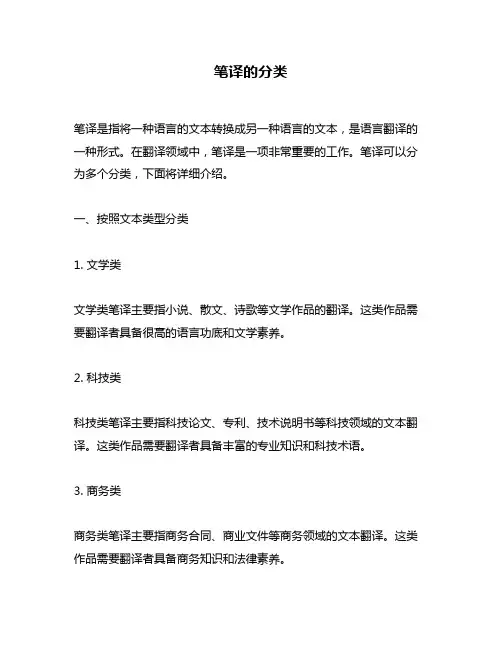
笔译的分类笔译是指将一种语言的文本转换成另一种语言的文本,是语言翻译的一种形式。
在翻译领域中,笔译是一项非常重要的工作。
笔译可以分为多个分类,下面将详细介绍。
一、按照文本类型分类1. 文学类文学类笔译主要指小说、散文、诗歌等文学作品的翻译。
这类作品需要翻译者具备很高的语言功底和文学素养。
2. 科技类科技类笔译主要指科技论文、专利、技术说明书等科技领域的文本翻译。
这类作品需要翻译者具备丰富的专业知识和科技术语。
3. 商务类商务类笔译主要指商务合同、商业文件等商务领域的文本翻译。
这类作品需要翻译者具备商务知识和法律素养。
4. 政治外交类政治外交类笔译主要指国际政治、外交文件等政治外交领域的文本翻译。
这类作品需要翻译者具备政治外交知识和国际事务理解能力。
5. 广告宣传类广告宣传类笔译主要指广告、宣传册等文本的翻译。
这类作品需要翻译者具备市场营销和广告创意能力。
6. 新闻媒体类新闻媒体类笔译主要指新闻报道、评论等新闻媒体领域的文本翻译。
这类作品需要翻译者具备新闻素养和时事理解能力。
二、按照语言类型分类1. 英语笔译英语是世界上使用最广泛的语言之一,英语笔译是最常见的一种笔译形式。
英语笔译需要翻译者具备扎实的英语基础和良好的英文写作能力。
2. 日语笔译日本是一个经济发达、科技领先的国家,日本文化也深受世界各地人民喜爱。
因此,日语笔译在国际交流中也扮演着重要角色。
日语笔译需要翻译者具备扎实的日语基础和对日本文化的了解。
3. 法语笔译法国是世界上最著名的旅游胜地之一,同时也是一个文化大国。
因此,法语笔译在旅游、文化等领域中扮演着重要角色。
法语笔译需要翻译者具备扎实的法语基础和对法国文化的了解。
4. 德语笔译德国是一个工业强国,德语在科技、商务等领域中有着广泛应用。
因此,德语笔译在这些领域中也扮演着重要角色。
德语笔译需要翻译者具备扎实的德语基础和对德国文化的了解。
5. 俄语笔译俄罗斯是一个拥有悠久历史和丰富文化的国家,在政治、经济、文化等领域中都有着广泛影响力。
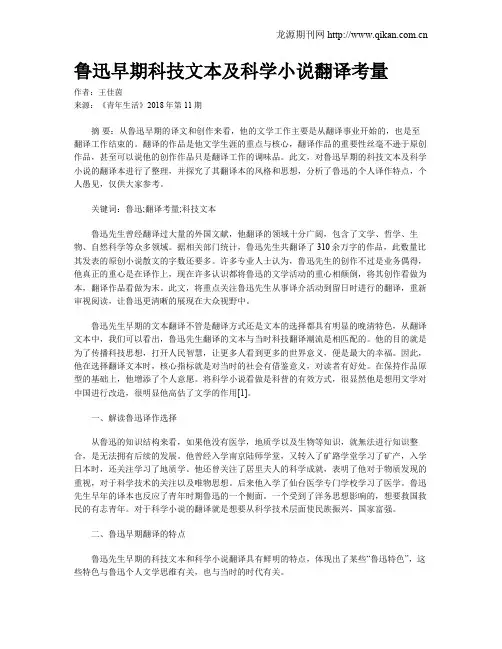
鲁迅早期科技文本及科学小说翻译考量作者:王佳茵来源:《青年生活》2018年第11期摘要:从鲁迅早期的译文和创作来看,他的文学工作主要是从翻译事业开始的,也是至翻译工作结束的。
翻译的作品是他文学生涯的重点与核心,翻译作品的重要性丝毫不逊于原创作品,甚至可以说他的创作作品只是翻译工作的调味品。
此文,对鲁迅早期的科技文本及科学小说的翻译本进行了整理,并探究了其翻译本的风格和思想,分析了鲁迅的个人译作特点,个人愚见,仅供大家参考。
关键词:鲁迅;翻译考量;科技文本鲁迅先生曾经翻译过大量的外国文献,他翻译的领域十分广阔,包含了文学、哲学、生物、自然科学等众多领域。
据相关部门统计,鲁迅先生共翻译了310余万字的作品,此数量比其发表的原创小说散文的字数还要多。
许多专业人士认为,鲁迅先生的创作不过是业务偶得,他真正的重心是在译作上,现在许多认识都将鲁迅的文学活动的重心相颠倒,将其创作看做为本,翻译作品看做为末。
此文,将重点关注鲁迅先生从事译介活动到留日时进行的翻译,重新审视阅读,让鲁迅更清晰的展现在大众视野中。
鲁迅先生早期的文本翻译不管是翻译方式还是文本的选择都具有明显的晚清特色,从翻译文本中,我们可以看出,鲁迅先生翻译的文本与当时科技翻译潮流是相匹配的。
他的目的就是为了传播科技思想,打开人民智慧,让更多人看到更多的世界意义,便是最大的幸福。
因此,他在选择翻译文本时,核心指标就是对当时的社会有借鉴意义,对读者有好处。
在保持作品原型的基础上,他增添了个人意愿。
将科学小说看做是科普的有效方式,很显然他是想用文学对中国进行改造,很明显他高估了文学的作用[1]。
一、解读鲁迅译作选择从鲁迅的知识结构来看,如果他没有医学,地质学以及生物等知识,就無法进行知识整合,是无法拥有后续的发展。
他曾经入学南京陆师学堂,又转入了矿路学堂学习了矿产,入学日本时,还关注学习了地质学。
他还曾关注了居里夫人的科学成就,表明了他对于物质发现的重视,对于科学技术的关注以及唯物思想。
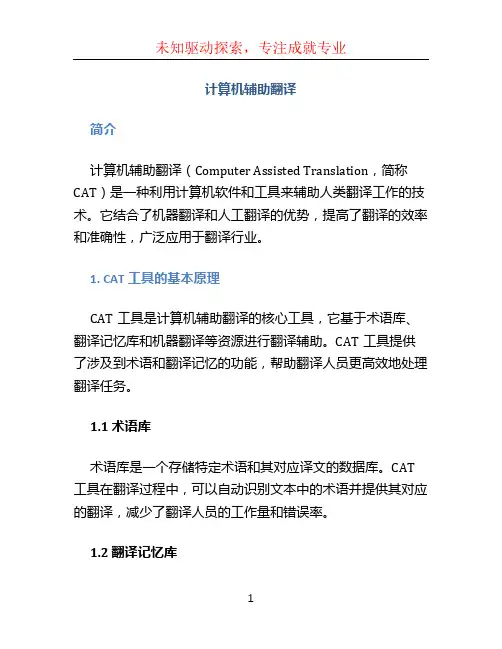
计算机辅助翻译简介计算机辅助翻译(Computer Assisted Translation,简称CAT)是一种利用计算机软件和工具来辅助人类翻译工作的技术。
它结合了机器翻译和人工翻译的优势,提高了翻译的效率和准确性,广泛应用于翻译行业。
1. CAT工具的基本原理CAT工具是计算机辅助翻译的核心工具,它基于术语库、翻译记忆库和机器翻译等资源进行翻译辅助。
CAT工具提供了涉及到术语和翻译记忆的功能,帮助翻译人员更高效地处理翻译任务。
1.1 术语库术语库是一个存储特定术语和其对应译文的数据库。
CAT 工具在翻译过程中,可以自动识别文本中的术语并提供其对应的翻译,减少了翻译人员的工作量和错误率。
1.2 翻译记忆库翻译记忆库是存储之前翻译过的句子及其对应译文的数据库。
当翻译人员在翻译新文本时,CAT工具会自动搜索翻译记忆库中类似的句子,并提供其对应的译文作为参考,提高翻译的一致性和效率。
1.3 机器翻译机器翻译是利用计算机算法和模型来自动翻译文本的技术。
CAT工具可以集成机器翻译引擎,当遇到无法从术语库和翻译记忆库中找到翻译的文本时,可以自动调用机器翻译引擎进行翻译。
2. CAT工具的优势2.1 提高翻译效率CAT工具通过术语库和翻译记忆库的利用,大大提高了翻译效率。
翻译人员可以直接从术语库中选择术语的翻译,节省了查词的时间;同时,翻译记忆库可以提供类似句子的参考翻译,减少了重复翻译的工作量。
根据统计数据,使用CAT工具进行翻译可以提高翻译效率30%以上。
2.2 保持翻译一致性CAT工具在翻译过程中,通过翻译记忆库的利用,可以保持翻译的一致性。
如果同一个术语在不同的文档中被多次使用,翻译人员可以直接使用翻译记忆库中的翻译,确保在不同文档中相同的术语都被翻译成一致的译文。
2.3 提高翻译准确性CAT工具可以提供术语的译文和类似句子的参考翻译,帮助翻译人员更准确地理解和翻译文本。
此外,集成机器翻译引擎的CAT工具还可以自动进行翻译,提供机器翻译结果供翻译人员参考,进一步提高翻译准确性。
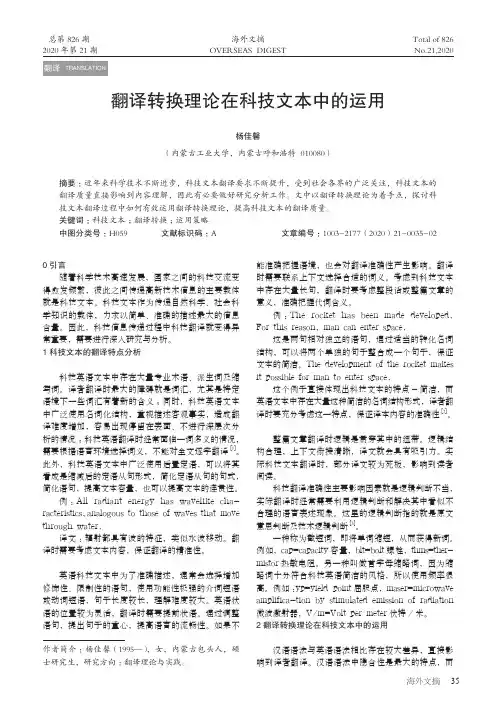
35海外文摘OVERSEAS DIGEST 海外文摘2020年第21期总第826期No.21,2020Total of 8260 引言随着科学技术高速发展,国家之间的科技交流变得愈发频繁,彼此之间传递高新技术信息的主要载体就是科技文本。
科技文本作为传递自然科学、社会科学知识的载体,力求以简单、准确的描述最大的信息含量。
因此,科技信息传递过程中科技翻译就变得异常重要,需要进行深入研究与分析。
1 科技文本的翻译特点分析1.1 词汇特点科技英语文本中存在大量专业术语、派生词及缩写词。
译者翻译时最大的障碍就是词汇,尤其是特定语境下一些词汇有着新的含义;同时,科技英语文本中广泛使用名词化结构,重视描述客观事实,造成翻译难度增加,容易出现停留在表面、不进行深层次分析的情况;科技英语翻译时经常面临一词多义的情况,需要根据语言环境选择词义,不能对全文逐字翻译[1]。
此外,科技英语文本中广泛使用后置定语,可以将其看成是缩减后的定语从句形式,简化定语从句的句式,简化语句,提高文本容量,也可以提高文本的连贯性。
例:All…radiant…energy…has…wavelike…cha-racteristics,analogous…to…those…of…waves…that…move…through…water.译文:辐射都具有波的特征,类似水波移动。
翻译时需要考虑文本内容,保证翻译的精准性。
1.2 结构特点英语科技文本中为了准确描述,通常会选择增加修饰性、限制性的语句,使用功能性极强的介词短语或动词短语,句子长度较长,理解难度较大。
英语状语的位置较为灵活,翻译时需要提前状语。
通过调整语句,提出句子的重心,提高语言的流畅性。
如果不能准确把握语境,也会对翻译准确性产生影响。
翻译时需要联系上下文选择合适的词义。
考虑到科技文本中存在大量长句,翻译时要考虑整段话或整篇文章的意义,准确把握代词含义。
例:The…rocket…has…been…made…developed.For…this…reason,man…can…enter…space.这是两句相对独立的语句,通过适当的转化名词结构,可以将两个单独的句子整合成一个句子,保证文本的简洁。
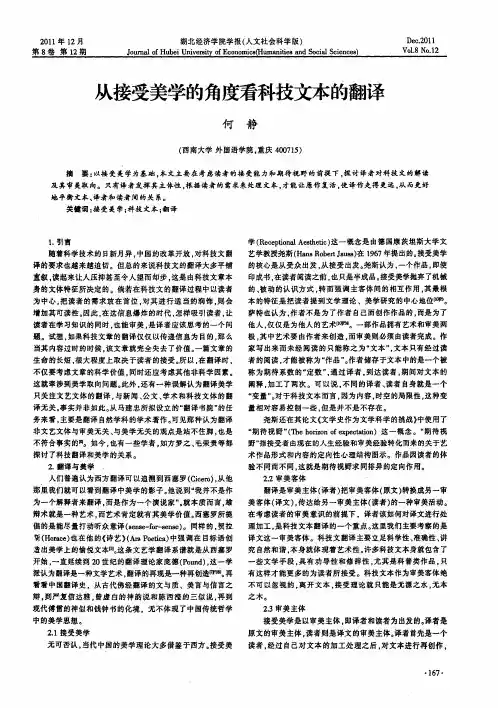
2011年12月 第8卷第12期 湖北经济学院学报(人文社会科学版)
Journal of Hubei Univer8it,/of Economics(Humanities and Social Sciences Dec.201 1
V01.8 No.12
从接受美学的角度看科技文本的翻译 何静 (西南大学外国语学院,重庆400715) 摘要:以接受美学为基础。本文主要在考虑读者的接受能力和期待视野的前提下,探讨译者对科技文的解读 及其审美取向。只有译者发挥其主体性。根据读者的需求来处理文本,才能让原作复活,使译作走得更远,从而更好 地平衡文本、译者和读者间的关系。 关键词:接受荧学;科技文本;翻译
1.引言 随着科学技术的日新月异,中国的改革开放,对科技文翻 译的要求也越来越迫切。但总的来说科技文的翻译大多平铺 直叙。读起来让人压抑甚至令人望而却步,这是由科技文章本 身的文体特征所决定的。倘若在科技文的翻译过程中以读者 为中心,把读者的需求放在首位,对其进行适当的润饰,则会 增加其可读性。因此,在这信息爆炸的时代,怎样吸引读者,让 读者在学习知识的同时。也能审美,是译者应该思考的一个问 题。试想,如果科技文章的翻译仅仅以传递信息为目的。那么 当其内容过时的时候,该文章就完全失去了价值。一篇文章的 生命的长短,很大程度上取决于读者的接受。所以,在翻译时, 不仅要考虑文章的科学价值。同时还应考虑其他非科学因素。 这就牵涉到美学取向问题。此外。还有一种误鹪认为翻译美学 只关注文艺文体的翻译,与新闻、公文、学术和科技文体的翻 译无关。事实并非如此。从马建忠所拟设立的“翻译书院”的任 务来看,主要是翻译自然学科的学术著作。可见那种认为翻译 非文艺文体与审美无关、与美学无关的观点是站不住脚。也是 不符合事实的田。如今,也有一些学者,如方梦之、毛荣贵等都 探讨了科技翻译和美学的关系。 2.翻译与美学. 人们普遍认为西方翻译可以追溯到西塞罗(Ciceroj,从他 那里我们就可以看到翻译中美学的影子。他说到“我并不是作 为一个解释者来翻译。而是作为一个演说家”。就本质而育。雄 辩术就是一种艺术,而艺术肯定就有其美学价值。西塞罗所提 倡的是能尽量打动听众意译(sense-for-sense)。同样的,贺拉 新(Horace)也在他的《诗艺》(Am Poefica)中强调在目标语创 鼍出美学上的愉悦文本131。这条文艺学翻译系谱就是从西塞罗 开始,一直延续到20世纪的翻译理论家庞德(Pound),这一学 派认为翻译是一种文学艺术。翻译的再现是一种再创造1711'1 。再 看看中国翻译史,从古代佛经翻译的文与质、美育与信言之 辩,到严复信达雅。曾虚自的神韵说和陈西滢的三似说,再到 现代傅雷的神似和钱钟书的化境。无不体现了中国传统哲学 中的美学思想。 2.1接受美学 无可否认,当代中国的美学理论大多借鉴于西方。接受美 学(Rccepfional Aesthetic)这一概念是由德国康茨坦斯大学文 艺学教授尧斯(Hans Robert Jauss)在1967年提出的。接受美学 的核心是从受众出发,从接受出发。尧斯认为,一个作品,即使 印成书,在读者阅读之前,也只是半成品。接受美学抛弃了机械 的、被动的认识方式,转而强调主客体间的相互作用,其最根 本的特征是把读者提到文学理论、美学研究的中心地位【 。 萨特也认为,作者不是为了作者自己而创作作品的,而是为了 他人。仅仅是为他人的艺术[tOllS。一部作品拥有艺术和审美两 极,其中艺术要由作者来创造,而审美则必须由读者完成。作 家写出来而未经阅读的只能称之为“文本”,文本只有经过读 者的阅读,才能被称为“作品”。作者储存于文本中的是一个被 称为期待系数的“定数”,通过译者,到达读者,期间对文本的 阐释,加工了两次。可以说,不同的译者、读者自身就是一个 “变量”。对于科技文本而言,因为内容,时空的局限性,这种变 量相对容易控制一些,但是并不是不存在。 尧斯还在其论文《文学史作为文学科学的挑战》中使用了 “期待视野”(The horizon of expectation)这一概念。“期待视 野”指接受者由现在的人生经验和审美经验转化而来的关于艺 术作品形式和内容的定向性心理结构图示。作品因读者的体 验不同而不同。这就是期待视野求同排异的定向作用。 2.2审美客体 ‘ 翻译是审美主体(译者)把审美客体(原文)转换成另一审 美客体(译文),传达给另一审美主体(读者)的一种审美活动。 在考虑读者的审美意识的前提下,译者该如何对译文进行处 理加工。是科技文本翻译的一个重点。这里我们主要考察的是 译文这一审美客体。科技文翻译主要立足科学性、准确性、讲 究自然和谐。本身就体现着艺术性。许多科技文本身就包含了 一些文学手段,具有劝导性和修辞性,尤其是科普类作品,只 有这样才能更多的为读者所接受。科技文本作为审美客体绝 不可以忽视的,离开文本,接受理论就只能是无源之水,无本 之木。 2.3审美主体 接受美学是以审美主体。即译者和读者为出发的。译者是 原文的审美主体,读者则是译文的审美主体。译者首先是一个 读者,经过自己对文本的加工处理之后,对文本进行再创作。
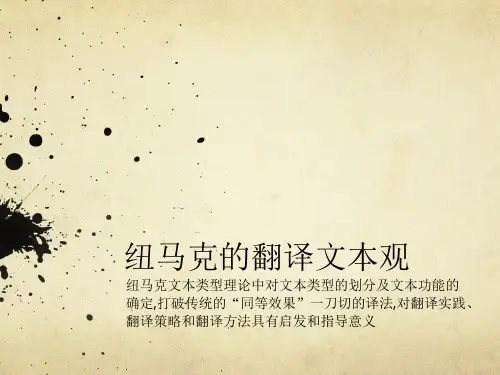
卡特福德翻译转换理论指导下科技英语文本汉译方法探究作者:郭敏来源:《校园英语·下旬》2021年第09期【摘要】科技文本以客观、准确提供科学信息、传播真理和规律为主要目的,其翻译重在语义表达。
卡特福德翻译转换理论强调译者的任务是寻求原文和译文在内容上等值,而不仅是形式上的对应,这与科技文本翻译突出“内容大于形式”的翻译目的是一致的。
本文基于卡氏翻译转换理论用实例探讨科技英语文本的汉译方法,以期探究该理论对科技英语文本的汉译指导作用和翻译策略,进一步提高科技英语文本的汉译文本质量,为科研和人文交流提供保障。
【关键词】卡特福德翻译转换理论;科技英语文本;汉译方法【作者简介】郭敏(1986.04-),女,汉族,河南宁陵人,青海建筑职业技术学院,助教,研究方向:英语教育、英语翻译。
一、科技文本的一般性特征从广义上来讲,科技文本不仅包括自然科学领域的科学技术内容,也涵盖社会科学领域的人文社会学科,同时也包括商务类、外贸类、广告、说明书、公文、契约文本、计算机技术、新闻和旅游等文本。
科技文本通常具有以下特征,一是用词精准、文体朴实。
二是使用术语、专业性强。
三是措辞严谨、逻辑性强。
因此在翻译科技文本时要最大限度保持原文本的行文风格,确保术语翻译与国际标准、国家标准和行业标准相一致,并在符合目的语表达习惯的前提下实现内容科学准确、衔接紧密。
二、翻译转换理论指导科技文本翻译的可行性分析卡特福德在其著作《翻译的语言学理论》中区分了“文本对等”和“形式对应”两个概念。
他认为“文本对等”是指特定语境中任何译语文本或部分文本成为一段给定原语文本或部分文本的等值成分。
“形式对应”是指在译语的“机体”中尽可能占有与该原语范畴在原语中占有的同等地位。
因英汉两种语言各有其基本特点,所以两种语言在形式对应上几乎总是近似的。
因此对科技英语的翻译重在表意,译文在形式上不必与原文一一对应,实现内容比形式重要是科技英语文本翻译的重要标准之一。
论科技英语文本中后置定语的翻译策略后置定语是指修饰名词的形容词或从句位于名词之后的语法结构。
在科技英语文本中,后置定语的使用频率较高,因为科技领域涉及到大量专有名词和技术术语,需要通过后置定语来进一步解释和说明。
下面是论科技英语文本中后置定语的翻译策略:1. 直接翻译:有些后置定语可以直接翻译,例如形容词和介词短语。
这种情况下,需要注意保持修饰关系的一致性和完整性。
例如:The new software provides an easy-to-use interface.(这个新软件提供一个易于使用的界面。
)2. 转换为从句:有些后置定语比较复杂,需要将其转换成从句来更好地表达意思。
例如:The study revealed a correlation between excessive smartphoneuse and poor sleep quality.(这项研究揭示了过度使用智能手机和睡眠质量下降之间的关联。
)3. 描述名词:有些后置定语可以描述或补充名词,此时翻译策略可以将其作为名词的修饰语进行翻译。
例如:An algorithm is a set of instructions that tells a computer what to do.(算法是一组指示计算机如何操作的指令。
)4. 拆分翻译:某些后置定语可能过长或难以直接翻译,此时可以考虑将其拆分成多个部分进行翻译。
例如:The new virtual reality headset, which is designed for gamers, offers a more immersive gaming experience.(这个专为游戏玩家设计的新虚拟现实头盔提供了更具沉浸感的游戏体验。
)总之,翻译科技英语文本中的后置定语需要根据具体情况采取不同的翻译策略,注重上下文的一致性和修饰关系的完整性。
第五章科技文体的翻译第一节科技文体特点科技文章是科技研究人员研究成果的直接记录,或阐述理论,或描述实验。
文章内容一般比较专业,语言文字正规、严谨。
科技文章侧重叙事和推理,所以具有很强的逻辑性,它要求思维的准确和严密,语言意义连贯,条理清楚,概念明确,判断合理恰当,推理严谨。
科技文章一般不使用带有个人情感色彩的词句,而是以冷静客观的风格陈述事实和揭示规律。
此外,科技文章有时使用视觉表现手段(visual presentation),这也是其文体的一个重要特征。
常用的视觉表现手段是各种图表,如曲线图、设备图、照片图和一览表等。
图表具有效果直观,便于记忆和节省篇幅等优点。
如同语言的其他功能变体一样,科技文体并没有单独的词汇系统和语法系统。
除了专业术语和准专业术语之外,科技文章也使用大量的普通词汇,其中包括一般的实义词和用来组织句子结构的语法功能词(如介词、冠词、连接词等),只是由于科技文体具有特殊的交际功能和交际范围,人们才逐渐认识到识别和研究这种语言变体的重要性。
现代英语科技文体在文体风格及语言要素方面与现代汉语科技文体有许多相同之处。
科技文体可粗分为两大类别:专用科技文体和普通科技文体。
一般研究科技翻译的论著主要涉及普通科技文体,很少涉及专用科技文体。
专用科技文体按文体的正式程度(formality)依次包括基础理论科学论著、科技法律文本或强制性技术文本(专利文件、技术合同、技术标准等)以及应用科学技术论著、报告。
普通科技文体按文体的正式程度依次包括物质生产领域的操作规程、维修手册、安全条例,消费领域的产品说明书、使用手册、促销材料,以及低级科普读物、教材等。
下面我们将分别探讨科技英语和科技汉语的问题特点。
一、科技英语的特点专用科技文体的语场包括技术性法律条文、基础科学理论、原理,涉及科学试验及科学技术研究等领域。
语旨是专家写给专家看的(expert-to-expert writing)。
语式中,抽象程度很高的基础科学理论的论著以人工语言为主,辅以自然语言,不是行家的翻译工作者难以理解。
翻译转换理论视角下的科技英语翻译摘要近年来,随着科学技术的不断进步,对于科技英语汉译工作的要求也更高。
而科技类文本属于信息类文本,翻译时的主要侧重点在于准确传达原文的信息。
卡特福德翻译转换理论是建立在以牺牲形式对等为原则的基础之上的,更侧重于语义对等的翻译策略。
本文基于卡特福德的转换理论,结合科技翻译实例,分析科技英语翻译,旨在为科技英语汉译提供新的见解。
关键词:科技英语;卡特福德翻译转换理论Ⅰ引言如今我们处在信息时代,在这一时代里,经济、科技迅速发展,科技已经逐渐渗透到了我们每个人的生活中。
作为知识传播的载体,科技文献也是公众和某一领域的专家获取最前沿信息的基础。
但科技领域覆盖范围广泛,专业术语和长难句较多,对译者而言,做好科技翻译并非易事。
我国关于翻译方法策略的研究者很多,但很少有人从词汇、句法这些微观层面上开展细致研究,深入到翻译过程中的具体变化或者转换中去。
对科技翻译而言,如何提高译文质量和翻译速度,现已成为译员和研究员关注的重点。
本文从科技文本的特点出发,具体分析卡特福德翻译转换理论在科技英语翻译中的应用。
第一章翻译转换理论第一节翻译转换理论介绍翻译转换理论是由英国著名语言学家和翻译理论家,约翰·卡特福德(J. C. Catford) 提出的。
他的翻译的代表作是1965年由牛津大学出版社出版的《翻译的语言学理论》(A Linguistic Theory of Translation),也是其唯一一部翻译理论专著。
在书中他中定义了“转换”这一概念,即“在从源语到目的语的过程中偏离了形式上的对等。
”层次转换(level shift):卡特福德认为语言可以区分为以下四种可能的层次:语法层、词汇层、形态层和语音层。
层次转换是指,处于一种语言层次上的源语单位,具有处于不同语言层次上的译语等值成分。
翻译中唯一的层次转换是语法-词汇转换。
范畴转换(category shift):范畴转换指的是不受限制的翻译和等级限制的翻译,是翻译过程中形式对应的偏离。
论科技英语文本中后置定语的翻译策略在科技英语文本中,后置定语是指紧跟在名词后面的修饰语。
后置定
语在翻译时需要考虑如何准确表达修饰作用,同时保持语言简洁、流畅。
以下是几种常用的翻译策略:
1.直接翻译后置定语。
直接将后置定语翻译成中文,放在名词后面。
这种方法适用于定语与
名词之间的关系比较简单、意思一目了然的情况。
例如:
(由一组工程师开发的移动应用已经变得非常流行。
)。
2.翻译后置定语并改变顺序。
有时为了避免中文过于复杂,可以将后置定语翻译后移动到名词前面。
这种方法需要注意调整语序,确保中文的流畅性和语言习惯。
例如:
- A new algorithm, designed for image recognition, has been developed.
(一种专门用于图像识别的新算法已经开发出来了。
)。
3.将后置定语转换成从句。
如果后置定语比较复杂或具有较强的描述性,可以将其转换成从句来
表达。
这种方法需要注意把握从句的结构和语态,以确保翻译的准确性。
例如:
(这项技术已在实验室进行了广泛测试,现在已经可以商业化使用了。
)。
综上所述,翻译科技英语文本中的后置定语需要根据具体情况灵活运用不同的策略,同时注意语言表达的简洁性和准确性。